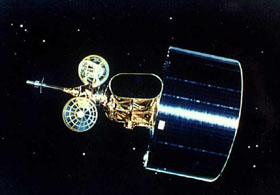GMS (Geosynchronous Meteorological Satellite)

GMS-3.
The GMS (Geosynchronous Meteorological Satellite) series of weather satellites is managed by the Japanese Meteorological Agency and NASDA (National Space Development Agency); their indigenous name Himawari means "sunflower." All have been located in geostationary orbit at 140° E.
The first GMS was launched in 1977. GMS-5, launched on 18 March 1995, was equipped with a VISSR (Visible and Infrared Spin Scan Radiometer), which scans Earth's surface line by line, each line consisting of a series of pixels. For each pixel the radiometer measures the radiative energy at three different wavelengths bands – one in the visible region and two in the infrared.
After the GMS-6, the GMS series was replaced by a Multifunctional Transport Satellite series to broaden its scope of operation. It is operated by the Japan Meteorological Agency for climatic observation.


